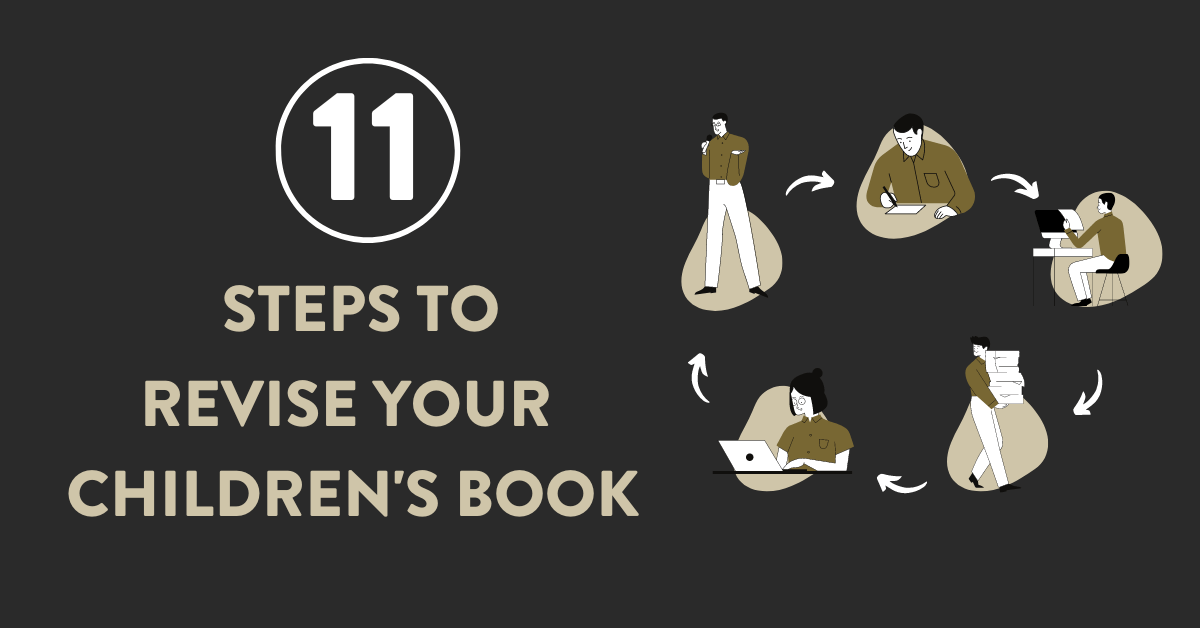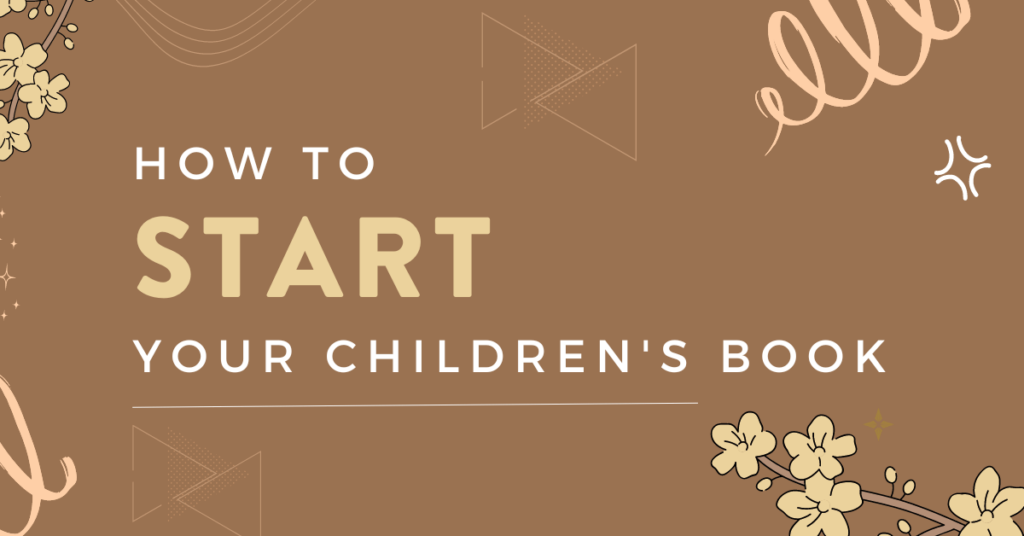
So you’ve taken the brave leap into the colorful world of children’s picture books. You’ve poured your heart, soul, and maybe a few late-night snack crumbs onto those pages.
But before you present your masterpiece to the tiny critics (a.k.a. kiddos), there’s one major step left: revision.
“Wait, what? I thought I was done when I typed the last word!” I hear you. But trust me, this step is just as creative and crucial. Let’s jump into it, step by step.
Here are the 11 steps every writer should take when revising their picture book.
1. Get Distance
First things first, put your book down for a bit.
Yep, you heard me! Take a week or two away from it. This will allow you to come back with fresh eyes and a clearer perspective. Plus, it’s an excuse for some R&R.
If you try to edit right after finishing the book, you’re going to be too close to it, and you won’t be able to make the hard choices and cuts that the book needs.
Instead of fretting over this book, do these three things:
- Start the next book: You don’t have to start writing it, but perhaps start imagining it. This will give you a head start when it’s time to start working on this next book.
- Set a Reminder: Mark a date on your calendar for when you’ll revisit your work. This keeps you accountable and ensures your book doesn’t gather metaphorical dust. I suggest two weeks as a standard time frame.
- Trust the Process: If you’re worried about losing momentum, remember that sometimes, the best ideas and clarity come after a brief respite. The book isn’t going anywhere. You just need to clear your brain so you can make it even better.
Children’s picture books are a dance of words and images. While the text tells a story, illustrations amplify it, adding layers of depth, humor, and heart.
2. Sketch the Illustrations
In order to revise the text, you’re going to need an idea of what the illustrations will do.
So it’s a good idea to sketch the illustrations, or at least describe them in brackets, like so: [Johnny bikes to the store]
Here are 4 ways to do that:
- Thumbnails: Even if drawing isn’t your forte, sketch out basic shapes or use stick figures. Thumbnails are small, quick sketches representing each page. They give a visual map of your story’s flow.
- Storyboards: These are a step up from thumbnails. Think of them as comic book panels for your story. You can block out where the text might go and what major action or emotion you want the image to convey on that page.
- Use Software: Not a fan of hand-drawing? Software like Storyboard That or even PowerPoint can be tools for creating digital storyboards.
- Stock Photos or Magazines: If drawing feels too daunting, clip out images from magazines or print stock photos that capture the essence of what you envision on each page. Make a mood board or a collage to visualize your story.
Remember, these sketches and boards aren’t about creating art—it’s about understanding pacing, ensuring there’s a balance of text and imagery, and seeing if there are any gaps in your story.
I have a post here on Bookfox that helps authors work with illustrators, so you might want to give that a read when you’re ready for the illustration process.
3. Read Aloud
One of the best ways to revise is to read your story out loud.
When you read your story out loud, you’re not just listening for content; you’re tuning into the rhythm, flow, and musicality of the words. This is especially crucial for children’s books, which often possess a lyrical quality.
It also gives you a sense of how parents will read this to their children.
How to Ace the Read Aloud Test:
- Record Yourself: Use your phone or any recording device. Play it back and listen. Do some parts sound clunky? Do you stumble over particular sentences?
- Watch Your Audience: If you’re reading to a child, pay close attention to their reactions. Are they fidgeting or looking away at a particular page? Or are they leaning in, eager to turn to the next page?
- Vary Your Tone: Try giving different characters distinct voices. It can help highlight any dialogue that doesn’t quite feel natural for a character.
- Mind the Length: While you’re reading, see if it feels too long or too short. Remember, you’re aiming for a story that’s engaging from start to finish, but concise enough to keep young minds captivated.
If you’re a visual learner, I also help authors with the revision process in my children’s book course, “Two Weeks to Your Best Children’s Book.”
4. Keep it Simple, Sweetie
When I edit for clients, the rule of “simplicity” is my guiding light. I’m always looking for places to make the book as simple as possible.
It’s the “Occam’s Razor” rule. The simplest explanation is often best, and the simplest book with only the most essential pieces is often the best book.
If your book confuses the child reader, there’s nothing that can save it — and clarity is often achieved through simplicity.
But … simplicity doesn’t mean sacrificing depth or meaning.
Navigating the Sea of Simplicity:
- Chop Chop: Go through your manuscript and ask yourself, “Is this word, sentence, or paragraph absolutely necessary?” If not, consider trimming it.
- Show, Don’t Tell: In a picture book, you have the advantage of illustrations to convey a lot of the information. If the text and the image are saying the same thing, choose one. Often, the image is more powerful.
- Big Words: While it’s okay to introduce young readers to new vocabulary, make sure the context makes the word’s meaning clear. And balance any complex words with simpler ones to maintain a flow.
- Active Voice Over Passive: Instead of “The ball was thrown by Jane,” go for “Jane threw the ball.” It’s punchier and more engaging.
- Ruthless Revising: The first draft is just that—a draft. Don’t be afraid to rearrange, rewrite, or remove chunks of your story to make it as tight and vibrant as possible.
By paying close attention to the simplicity of your story, you’re ensuring it’s a delightful read (and re-read!) for your little audience. After all, there’s no greater compliment than a child asking, “Again!” at the end of your book.
5. Seek Feedback
Think of your story as a gem. By showing it to different people, you’re allowing it to be polished from all angles, revealing its best facets.
Even if you’ve thought about your story for decades, someone who’s just read it can offer a perspective that you never ever thought of before.
Making the Most of Feedback:
- Choose a Mix: Share your story with fellow writers, parents, teachers, and especially kids. Each group will provide insights based on their unique perspective.
- Open Ears, Thick Skin: Not all feedback will be praise, and that’s okay. Constructive criticism helps you grow and refine your story. Listen, reflect, and decide which advice aligns with your vision for the book.
- Ask Specific Questions: Instead of a general “What do you think?”, guide your readers. Ask things like “Did the ending satisfy you?”, “Was there a part that confused you?”, or “Which character did you like most and why?”
- Feedback Sessions: If possible, organize or participate in critique sessions or writer’s workshops. Discussing your work in a group setting can lead to valuable insights. Look up local meeting groups of SCBWI, who often have children’s book workshops that you can attend.
- Don’t listen to everyone. You’re going to get bad advice. Some people want to rewrite your book entirely, and others want you to write it how THEY would write it. Ignore all those people. Only listen to the people who you realize instinctually have offered the right advice.
If you’d like more advice on how to write a children’s book, check out my post, “How to Write a Children’s Book in 12 Steps.”
6. Diverse Perspectives
Publishing nowadays loves diversity. It’s much harder to get books published that don’t have any diversity at all.
Even if you’re self publishing, it’s essential for children to see diverse characters, cultures, and situations in the stories they read (and it gives you a bigger audience!).
How to Ensure Diversity and Authenticity:
- Do Your Research: If you’re writing about a culture, setting, or situation you’re not personally familiar with, dive deep into research. Read books, watch documentaries, attend cultural events, or even interview people who have lived the experiences you’re trying to depict.
- Sensitivity Readers: These are individuals who review manuscripts for cultural accuracy, representation, and potential biases. If your story features themes or characters from backgrounds different from your own, hiring or consulting a sensitivity reader is a must.
- Avoid Stereotypes: It’s easy to fall into the trap of portraying characters based on generalized or clichéd perceptions. Aim for depth, nuance, and authenticity.
- Diverse Illustrations: Ensure that the book’s illustrations also reflect a wide range of backgrounds, abilities, and experiences. Work closely with the illustrator to achieve this.
By seeking feedback and ensuring diverse perspectives, you not only enrich your story but also make it resonate with a broader audience. Remember, every child deserves to see a reflection of themselves in the magical world of books.
7. Check Your Emotions
Emotions are the heart of a children’s book (actually, they are the heart of every book). If your book doesn’t create strong emotions in the reader, it’s going to be a failure.
So take note of where your book creates those emotions. And then go through this emotional checklist:
- Have I created enough emotions? If you can’t pinpoint multiple places in your book where the reader should feel an emotion strongly, then the story isn’t working properly.
- Have I created a Range of Emotions? Fear, disgust, anger, envy, but also love, sympathy, optimism.
- Have I created an Emotional Arc? Just as stories have a narrative arc, they should also have an emotional arc. This doesn’t mean an emotional upheaval on every page, but there should be a clear emotional journey that complements the story’s events. For instance, the main character could go from sadness to happiness, or from loneliness to feeling comforted by friends.
- Have I ended on a High Note? While it’s okay to explore negative emotions like sadness or anger (they’re a part of life, after all), children’s stories often end on a hopeful or positive note. It leaves the reader with a sense of closure, hope, or excitement.
8. Do a Sensory Check
When crafting children’s picture books, it’s easy to lean heavily into the visual elements—after all, the term “picture” is right in the name!
But while your illustrator will conjure the visual feast that captures young readers’ eyes, the onus is on you, dear writer, to engage the other four senses.
Tips to Engage the Other Four Senses:
- Auditory Allure: Sound plays a pivotal role in setting the mood. The soft lullaby sung by a mother, the frenzied clatter of a train, or the distant hoot of an owl can transport little readers right into the scene.
- Tactile Tales: Think about textures and touch. The slippery feel of a fish, the rough texture of a tree’s bark, or the comforting softness of a teddy bear can all evoke strong emotions and memories.
- Olfactory Adventures: Scent is closely tied to memory and emotion. The smell of freshly baked bread might bring warmth and comfort, while the sharp tang of the sea can evoke adventure and curiosity.
- Tasty Flavors: Even if your story isn’t centered around food, don’t forget taste. A sour lemon, sweet honey, or the blandness of porridge can make scenes more relatable and engaging.
As you revise, remember not to overload your narrative with sensory details on every page, or you might overwhelm your young readers. The key is balance. Intersperse sensory elements where they naturally fit, enhancing moments of emotion, tension, or discovery.
9. Condense Your Prose
Here’s the real challenge of revising a children’s book: trimming it down. Why? Kids have energy. Lots of it. But their attention is fleeting, so make every word count.
I’ve edited more than 1000 children’s books, and I’ve never seen a book that wouldn’t be better if it were at least a hundred or two hundred words shorter.
Because children’s books are so short, every single word carries ENORMOUS weight, as much as a whole page inside a novel for adults. You have to get every single word right, or else the book won’t work.
That means every word must be interrogated, and must earn its spot in the lineup.
Here are some examples of Condensed Magic:
- Before: “The sun was shining brightly in the sky, casting a warm, golden hue over everything.”
- After: “Golden sunlight bathed everything.”
- Before: “She felt really, truly, deeply sad about losing her teddy bear.”
- After: “She was heartbroken without her teddy.”
- Before: “With a massive burst of energy, he raced like the wind across the open field, his heart pounding rapidly.”
- After: “He raced across the field, heart pounding.”
- Before: “The ice cream was sweet, creamy, and had a taste that reminded her of summer days.”
- After: “The ice cream tasted like summer.”
See the difference? Condensing isn’t about losing meaning. It’s about packing a punch.
In revision, be ruthless. Your story deserves it.
10. Trim the Beginning
Many writers, seasoned and newbies alike, begin their stories with a leisurely stroll. It’s a natural instinct. We want to set the stage, introduce the world, give our readers a feel for the atmosphere. But guess what? More often than not, it’s possible to dive straight into the action and still achieve all that.
You want to hit the ground running, because you only have 26 pages to write this book. If you waste three or four pages setting up the story, you won’t have enough space left to tell your tale.
In my experience, about 1 out of 3 writers could significantly benefit from snipping off the first couple of lines—or even pages—of their manuscript.
Tips for a Punchy Beginning:
- Review the Start: Look at your first line. Is there action, a question, a mystery, or a unique scenario? If not, consider what can be trimmed.
- Trust Your Reader: Kids are intuitive. They often pick up on things quicker than we give them credit for. They don’t always need an elaborate setup to dive into a story.
- Test It Out: Delete the first few lines, then read your story. Does it still make sense? Is it more engaging? Sometimes, you might be surprised at how little those initial lines are missed.
Don’t start with the build up, or the description of the town or of the character. Start with a character doing something, or start with the character’s problem.
11. Delete a Character
We’ve all been there: You’re deeply attached to a character you’ve lovingly crafted—after all, they’ve been with you since the story’s inception.
But as you review your narrative, a nagging feeling emerges. Does this character truly add to the story’s depth, or are they muddling the waters? Here’s a little secret: sometimes, a story shines brighter when a character steps out of the spotlight.
Why Consider the Cut?
- Streamlining: Fewer characters can make the story clearer, especially for young readers.
- Focus: It helps the audience invest more deeply in the remaining characters.
- Pacing: Removing a superfluous character can accelerate the story’s pace, keeping those pages turning.
Questions to Ask Before Taking the Leap:
- Is their role vital? Can the story stand without them, or can their role be merged with another character?
- Do they have a clear arc or purpose? If they meander without growth or real impact, it might be a sign.
- Does the story feel crowded? Sometimes, less truly is more.
The most important thing to do is reassign important actions. For instance, if your character had a crucial role or memorable trait, consider if it can be given to another character.
It’s okay to grieve a little. Deleting a character can feel like saying goodbye to an old friend. But always remember, they’re not truly gone. They live on in your writer’s toolbox, ready to star in a future story where they might fit just perfectly.
###
When you’re done with revision, it’s time to move onto publishing!
If you’re ready to publish, then consider Bookfox Press. We make it easy for authors to get their book out into the world, and we handle illustrations, formatting, ISBNs, editing, and everything else that you need.
Contact us by clicking on that link!



